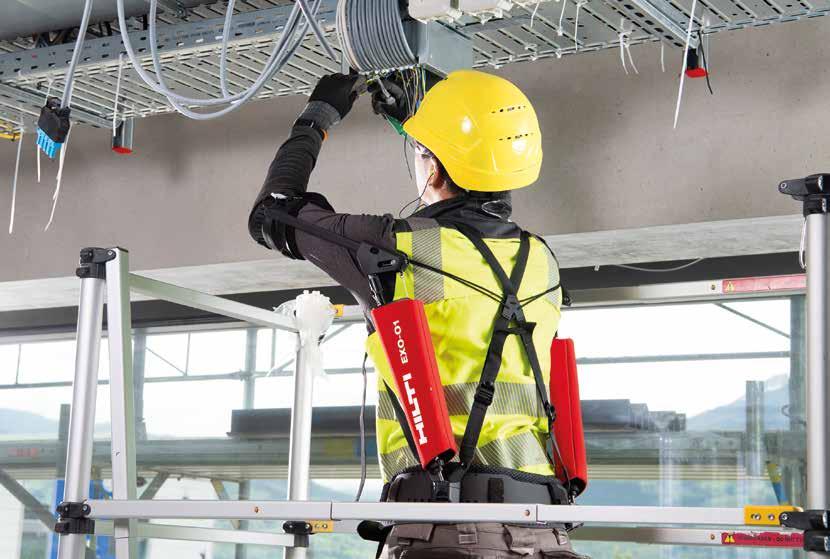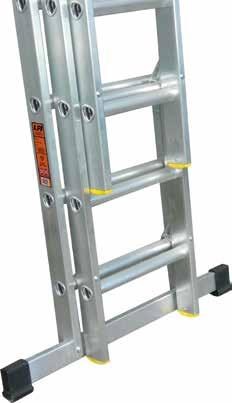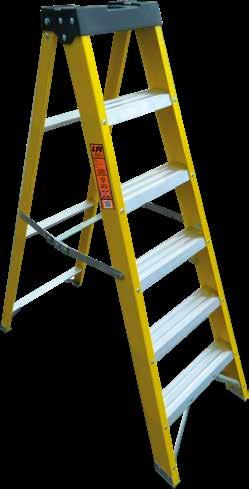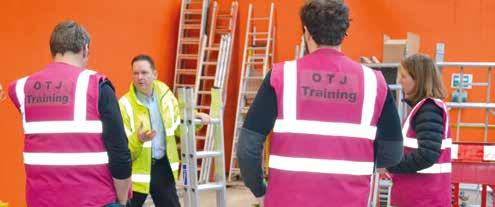
3 minute read
Exosceleton solutions come to the construction industry
from AccessPoint Issue 14
by AccessPoint
The construction technology group Hilti and the medical technology company Ottobock are combining their know-how in the fields of safety, health protection and biomechanics to expand their portfolio of ergonomic solutions. Both companies have decades of experience in their respective fields and will cooperate in the area of research and development in the future.
The standards governing the manufacture of ladders and steps is – in the main – covered by EN131. This in turn has several parts which address dimensions, material specification, testing and labelling. The access industry saw the biggest change in recent memory a couple of years ago as the old British Standard Class 1 and 3 were withdrawn and the European market came to realise the new, improved, more durable, safer product.
The biggest physical change to ladders is easy to spot; manufacturers need to provide a more stable product and as such a ratio between extended height and the base width was introduced as part of the standard and so the majority have now added a stabiliser bar to be fitted at the base.

The Ladder Association is the representative industry body – they represent the collective power of manufacturers, users and training providers across the UK. It is their training courses which users can undertake to obtain the LadderCard which is awarded upon successful completion and will provide the holder with a pass (for 5 years) to acknowledge their competence and ability to work more safely.
It is widely acknowledged that falls from height remain one of the biggest causes of fatal injuries in the workplace (HSE Statistics) however this can be mitigated with the correct training and product selection.
When choosing the correct product there are a few key things to consider – the task itself (can I get to the place I need to be); the environment (is it safe, do I have flat, stable ground); and the user’s competence. All ladders and steps are provided with a set of instructions and clear labels to indicate safe use, again forming part of the EN131 standard. However, it is still always down to the user to make the final decision.
With many options being available, covering a variety of heights, prices and quality, choosing the correct ladder may seem daunting. However, items that will get the user to the right height and are made to the correct (current) standard are what to look out for. Buying a reputable, UK-made piece of access equipment will certainly add to the feeling of safety.

LFI have been manufacturing ladders in the UK since 1947 and continue to develop their range to meet and exceed the standards which govern these products. As a reputable manufacturer, LFI also provide training for ladder users along with other relevant courses.

FIND OUT MORE www.britishladders.co.uk
The Ladder Association provides a wealth of useful material relating to the safe use of access products, including downloads and online guides such as the ‘Correct Way To Use Ladders’: www.ladderassociation.org.uk/ guidance/using-a-ladder/
“Exoskeletons are an important trend having great relevance for us. They provide relief for physically demanding tasks, such as those performed on construction sites every day. In Ottobock we have the ideal partner to combine our user protection and ergonomics knowledge with 100 years of biomechanical expertise. Our technology partnership will serve as the basis for the development of additional innovative and customer-oriented systems,” explains Johannes Wilfried Huber, Head of Hilti’s Diamond Systems Business Unit.
“We are delighted to be opening up a new area of application together with Hilti. We are building on our experience gained from more than 500 successful exoskeleton projects, including in the automotive industry and various trades. There is a great deal of potential for solutions that reduce the physical strain on workers in the construction industry. We want to jointly expand this pillar in the coming years,” explains Dr. Sönke Rössing, Head of Ottobock Industrials. This division has been developing industrial exoskeletons from the Paexo product range since 2012 to create healthier workplaces.
Hilti will launch the first joint product, the EXO-O1, in Autumn 2020. It is a passive model that does not require an energy supply. The weight of the arms is transferred to the hips via the forearm supports using mechanical cable pulling technology. Independent studies and Ottobock research have shown that this reduces the peak load on the muscles and relieves shoulders by up to 47 percent.
Exoskeletons can therefore make a significant contribution to health protection, particularly regarding work performed above shoulder level and overhead work. In terms of the construction industry, this targets serial or continuous activities. Fatigue is also reduced. As a result, this type of work can be carried out over a longer period of time with much greater productivity.
Over the longer term, preventive relief can help reduce work-related musculoskeletal disorders in the shoulder area. These are some of the most common causes of worker disability in the construction industry and therefore pose a significant cost factor for companies and health care systems.
FIND OUT MORE www.hilti.co.uk
Application example: The Hilti EXO-O1 provides relief for workers carrying out repetitive applications performed above the shoulders or overhead.








